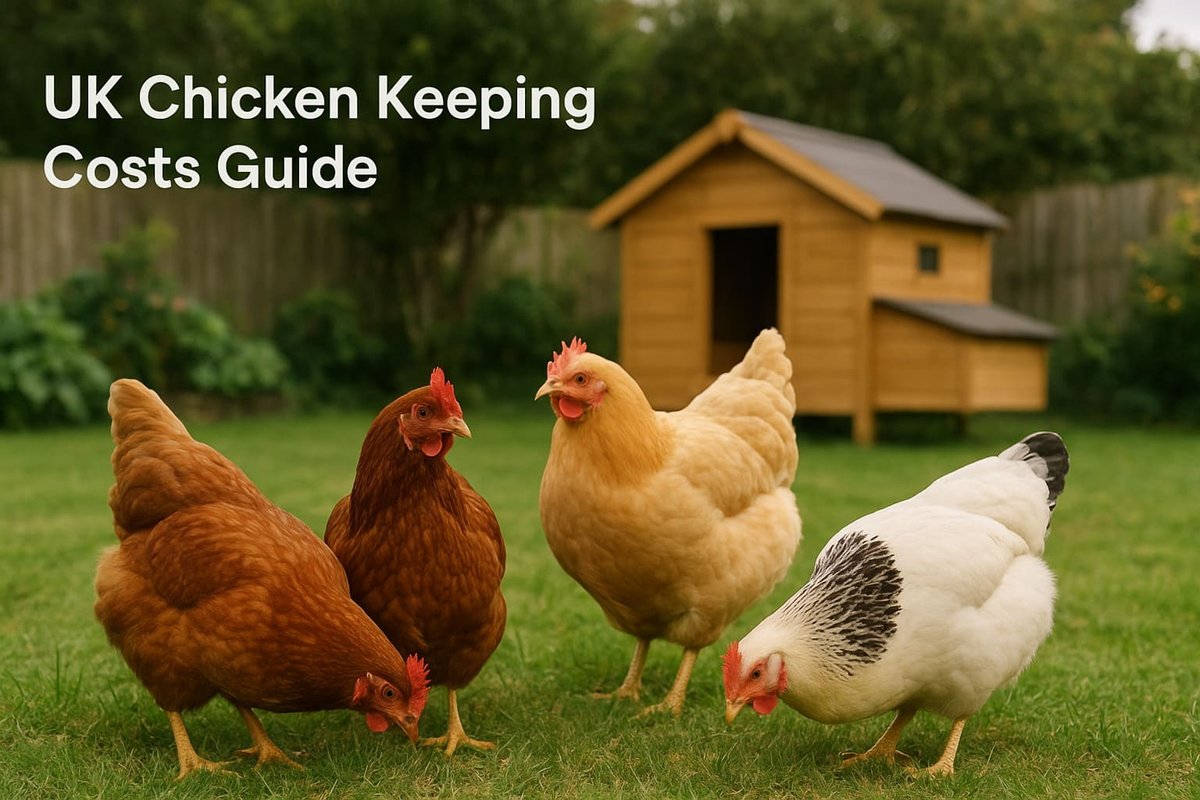When I brought home my first four chickens in 2023, I thought I’d budgeted perfectly. I’d set aside £800. By month three, I’d already spent nearly £1,200. I learned the hard way that the little costs—the ‘just-in-case’ mite powder, the sturdier feeder, the extra bedding—add up fast.
So, how much does it cost to keep chickens in the UK? For a typical backyard setup of 4 hens, you should budget between £1,000 and £1,500 for the first year. After that, you can expect your running costs to be much lower, at around £200 to £400 per year.
This guide will break down every single cost, from the coop and the chickens themselves to the monthly feed bills. We’ll cover the legal bits (don’t worry, they’re mostly free!) and answer whether it’s actually worth it for those fresh eggs. If you’re looking for a more general overview first, check out our complete guide to keeping chickens in the UK.
Quick Answer: What You’ll Really Spend (Estimate for 4 Hens)
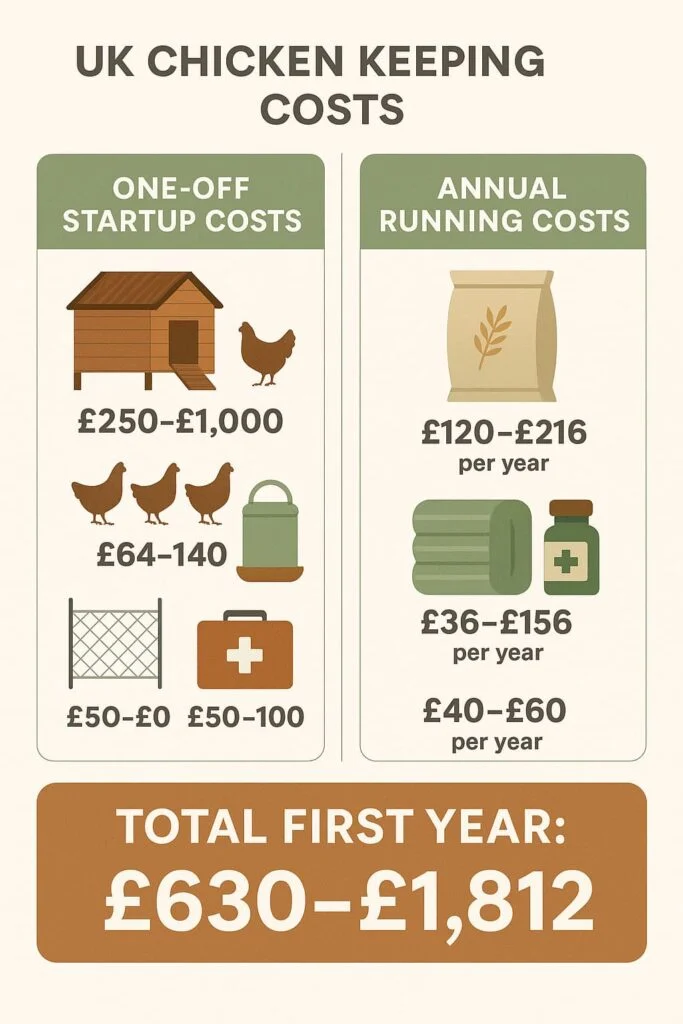
Here’s a quick look at the costs. We’ll dive into each of these, but this gives you a fast answer. This table is for a beginner’s flock of 4 hens, which is the number I always recommend starting with.
| Cost Category | One-Off Startup Cost | Ongoing Annual Cost (Year 1) |
|---|---|---|
| Chickens (4 POL Hens) | £64 – £140 | – |
| Coop & Housing | £250 – £1,000+ | – |
| Feeder & Drinker | £20 – £40 | – |
| Fencing & Run | £50 – £100 | – |
| Health & First-Aid Kit | £50 – £100 | – |
| Feed | – | £120 – £216 |
| Bedding | – | £36 – £156 |
| Healthcare (Worming, etc.) | – | £40 – £60 |
| Total First Year | £434 – £1,380 (Setup) | £196 – £432 (Running) |
| GRAND TOTAL (Year 1): | £630 – £1,812+ |
Prices verified October 2025.
My advice? Aim for that £1,200 budget. It’s better to have money left over than to be surprised. My £1,200 spend was because I had to upgrade my cheap coop, which I’ll explain later.
This quick summary gives you a great ballpark figure. But before you head out to buy a coop, there are some important legal steps you need to take.
Do I Need to Register My Chickens in the UK? (Legal Requirements First)
Before you buy a single chicken, let’s talk about the legal side. It sounds boring, but it’s vital, falls under YMYL (Your Money Your Life) rules, and thankfully, it’s not expensive.
Registration Costs and Requirements (It’s Free!)
Registration is completely free in the UK. You must register your birds within one month of keeping them, even if you only have one.
Since October 1, 2024, all chicken keepers in England and Wales must register their flocks, regardless of size. Previously, only flocks of 50+ birds required registration, but this law was expanded to improve biosecurity and disease tracking.
- Who: Anyone with poultry (chickens, ducks, geese, turkeys, etc.).
- How: You register with the APHA (Animal and Plant Health Agency) by signing up to the Great Britain Poultry Register (GBPR) online at GOV.UK.
- Why: This is a critical biosecurity measure. If there’s an outbreak of Avian Flu in your area, this register lets DEFRA (Department for Environment, Food & Rural Affairs) contact you quickly with instructions, such as needing to keep your birds indoors.
- Penalty: The fine for not registering can be up to £2,500. It’s free and takes 10 minutes, so it’s a complete no-brainer. (Source: GOV.UK)
How Many Chickens Can You Keep Without a Licence?
You can keep up to 49 birds without needing any special licence. Registration with the GBPR is still mandatory for everyone. The 50+ bird rule is for premises that are classed as commercial-scale, and they must register with the Poultry Register, which has different requirements. For any backyard flock, you’ll be well under this 50-bird limit.
What About Local Council Rules and Neighbours?
This is a step many beginners miss. The national laws are simple, but local rules can stop you.
- Check Your Deeds/Tenancy: Before you spend a penny, check your house deeds or rental agreement. Some properties have “covenants” that ban keeping livestock, and this almost always includes chickens.
- Local Council: Most councils are fine with a few hens, but they will take action if your chickens cause a nuisance. This usually means:
- Noise: This is why you should not get a cockerel. A crowing cockerel is a guaranteed way to get a complaint from your neighbours.
- Pests: You must keep feed secure to avoid attracting rats (more on this later).
- Smell: A well-kept coop doesn’t smell. A dirty one will.
- Chat to Your Neighbours: This is my top tip. Have a quick chat with your direct neighbours. Let them know your plan (and promise them some free eggs!). It’s much better to have them on your side from day one.
In short, be a responsible owner. This all falls under your legal duty of care to meet your chickens’ welfare needs, as outlined in the Animal Welfare Act 2006.
With the legal side sorted and your neighbours on board, let’s get to the exciting part: budgeting for your new flock and their home.
First-Year Startup Costs: Complete Breakdown
This is where you’ll spend most of your money. These are the one-off costs to get your chicken setup ready. Don’t be tempted to cut corners here; a good setup will save you money and heartache in the long run.
How Much Do Chickens Cost to Buy in the UK?

You have two main choices: day-old chicks or Point of Lay (POL) hens.
- Day-Old Chicks: These can cost between £2.50 and £40 per chick, depending on the breed’s rarity. This is the “hard mode” for beginners. You’ll also need a special brooder box, a heat lamp (which uses a lot of electricity), and special chick feed. It’s a lovely experience, but not one I’d recommend for a first-timer.
- Point of Lay (POL) Hens: This is what I suggest for 99% of beginners. These are young hens, typically 16-20 weeks old, who are just about to start laying eggs. They cost £16 to £35 per bird.
Choosing the right breed for your space is also key. If you’re working with a smaller area, you’ll want to look at the best chicken breeds for small UK gardens.
Here are a few popular beginner breeds and their typical UK costs:
- ISA Brown / Warren: The workhorse. Costs ~£18. A very friendly hybrid that will lay 300+ brown eggs in its first year. My ISA Browns are nosy, friendly, and fantastic layers.
- Buff Orpington: The family pet. More expensive at ~£30-£40. A large, fluffy, and incredibly calm bird. Lays fewer eggs (around 180 a year) and is known for going “broody” (wanting to sit on eggs). They’re wonderful birds; you can read our complete Buff Orpington breed guide to see if they’re right for you.
- Light Sussex: The classic all-rounder. Costs ~£25-£35. A beautiful white and black bird, very hardy, and lays around 250 light brown eggs a year.
If you’re interested in native birds, there are many other traditional British chicken breeds to consider, like the Dorking or the Scots Grey.
- Rescue Hens: You can also adopt ex-commercial hens from charities like the British Hen Welfare Trust (BHWT). For a small donation (usually £2.50-£5 per hen), you can give these hardworking girls a wonderful retirement. They will still lay plenty of eggs and are incredibly rewarding.
Beginner’s Tip: Start with 3 or 4 hens. This is a perfect number for a small flock and will give you plenty of eggs (around 12-24 a week in their prime).
Total Cost for 4 Hens: £64 – £140 (or just £10-£20 for rescues!)
Coop and Housing Costs
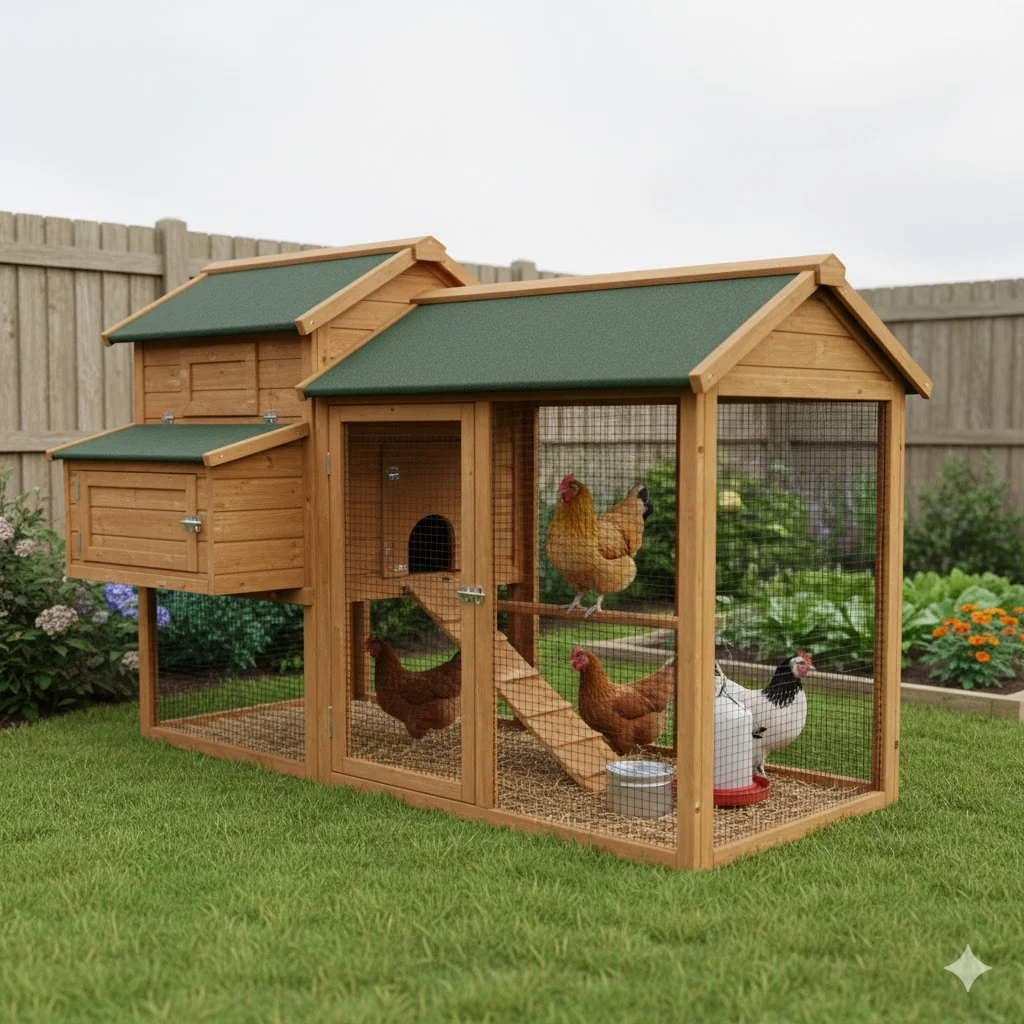
This will be your single biggest expense. A good coop is essential for keeping your chickens safe from predators (especially foxes) and the weather.
- Budget Coops: You can find basic flat-pack coops online for £150 – £300.
- Mid-Range Coops: A sturdier, better-quality wooden coop will cost £300 – £600.
- Premium Coops: Brands like Omlet offer plastic coops that are easy to clean and very secure. These can cost £500 – £1,000+.
My Experience: Why a Cheap Coop Costs You More
My first coop was a £200 flat-pack. It looked great online, but the wood was thin, the locks were flimsy, and it was a nightmare to clean. After one wet winter, the roof felt was leaking and the wood was starting to warp. This is a common issue, and keeping your coop dry in UK weather is a constant battle. A better quality coop helps massively.
Worse, the dozens of tiny cracks and gaps were a perfect hiding place for red mites (a chicken keeper’s worst enemy). I learned the hard way that a cheap coop needs replacing or repairing, costing you more in the long run. Learning about red mite prevention in wooden coops early is something I wish I’d done. I upgraded to a £450 coop made of thicker, treated timber, and the difference is night and day.
DIY Coop: The Budget-Friendly Option
If you’re handy, you can build a fantastic coop for a fraction of the cost. A popular option is building from reclaimed pallets (often free), costing you less than £50 for screws, hinges, and roofing felt. If you buy new timber, you could build a rock-solid coop for £200-£400.
Space Requirements: Make sure your coop has 2-4 square feet of space per bird inside, and at least 8-10 square feet per bird in their outside run. More is always better.
Total Cost for Coop: £250 – £1,000+
Essential Equipment and Supplies
You’ll need a few more bits to get started.
- Feeders and Drinkers (£20 – £40): Don’t skimp here. Cheap, flimsy plastic ones get brittle in the sun and get knocked over, wasting feed. Get a good-quality plastic or galvanised steel set. A “treadle feeder” (where the hen stands on a platform to open it) is more expensive (£50-£80) but is the best way to stop rats, as they aren’t heavy enough to open it.
- Fencing (£50 – £100): If your coop doesn’t have a large, secure built-in run, you’ll need electric poultry netting or wire fencing to create a safe area. A fox can tear through standard “chicken wire” – you need proper welded mesh.
- Healthcare & First-Aid Kit (£50 – £100): You should have this before you need it. My kit includes:
- Diatomaceous Earth (DE): For dusting the coop to prevent mites. We have a full guide on using diatomaceous earth for mite prevention.
- Purple Spray: A general antiseptic spray for any small cuts.
- Wound Powder: To stop bleeding if a feather gets broken.
- Vaseline: For treating scaly leg mites (you rub it on their legs).
- A Poultry Wormer: Such as Flubenvet (you’ll need to buy this from a registered supplier).
- Bedding (£10 – £15): You’ll need an initial bale of bedding, like straw or wood shavings.
Total Cost for Equipment: £130 – £255
That covers the big one-off purchases. Now let’s look at the costs that will become part of your regular monthly budget, starting with the biggest one: food.
How Much Do Chickens Cost Per Month? (Ongoing Expenses)
Once you’re set up, your “running costs” are much lower and more predictable. Here’s how much chickens cost per month.
Feed Costs (Your Main Monthly Bill)
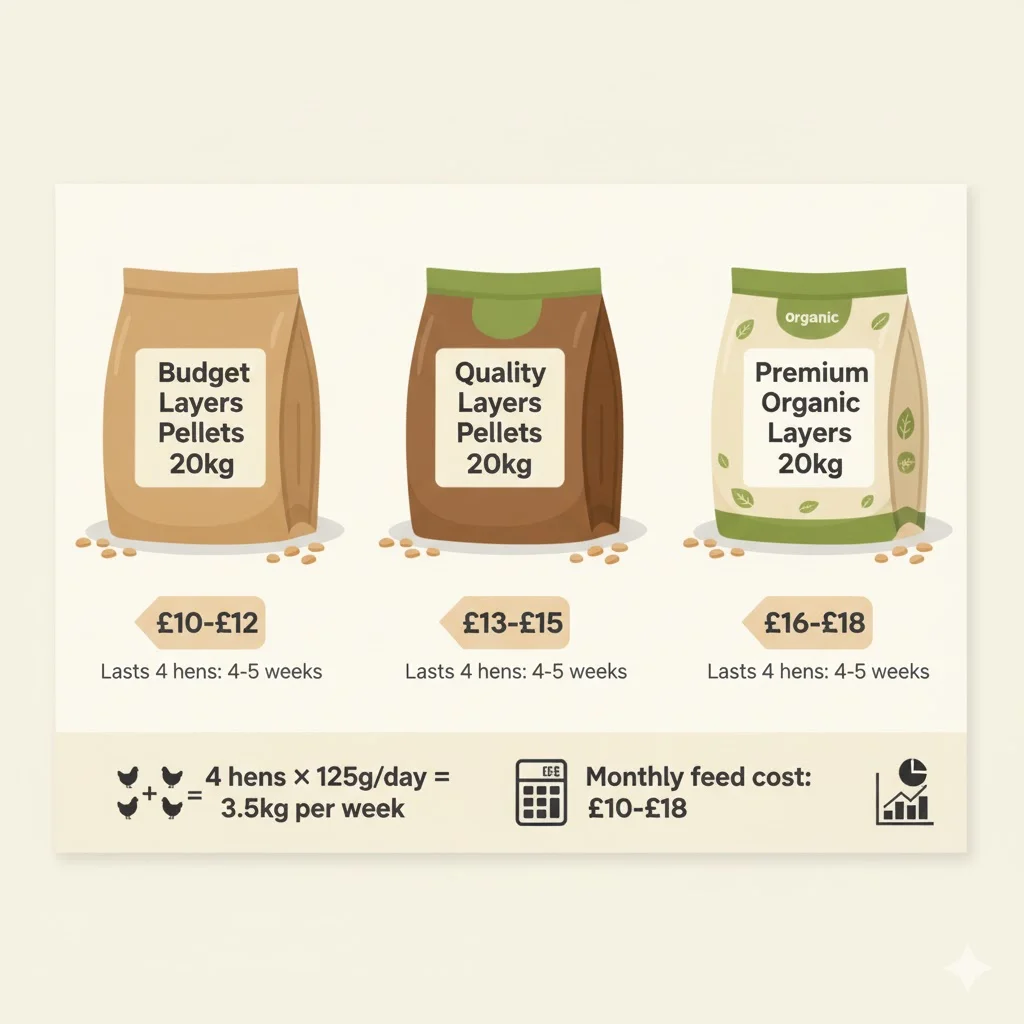
This will be your main monthly expense. A laying hen eats about 120-150g of layer feed (pellets or mash) per day.
- A 20kg bag of good-quality layers pellets costs £10 – £18. (I’ve updated this from £9-£15, as 2025 prices have crept up).
- For 4 hens, one 20kg bag will last you about 4-5 weeks.
- This works out to £10 – £18 per month.
What Type of Feed Should I Buy?
- Layers Pellets: This is the standard. It’s a complete, balanced diet for laying hens.
- Layers Mash: The same ingredients, but in a ground-up form. Some find it wasteful.
- Mixed Corn: This is a treat, not a complete food. It’s like giving sweets to a child. It’s great for scattering in the afternoon to encourage foraging (and for taming your hens!) but it’s not a balanced meal.
Choosing from recommended UK poultry feed brands can also ensure your hens are getting top-quality nutrition.
Annual Feed Cost: £120 – £216
The “No Kitchen Scraps” Law (A Critical YMYL Warning)
It is illegal to feed your chickens any kitchen waste in the UK. This is stated in the Animal By-Products regulations enforced by APHA.
This ban applies to all kitchen waste – even from vegan households – because any food that has passed through a domestic or commercial kitchen is classified as catering waste and poses biosecurity risks. The rule is “no kitchen scraps” to make it simple and remove all risk.
You can feed them:
- Greens picked fresh from your garden (that have not entered your kitchen). For example, you can bring vegetables or greens directly from your garden or shop via a side gate, without them passing through your kitchen.
- Shop-bought grains (like corn).
- Approved poultry treats.
Bedding Costs
You’ll need to regularly clean out the coop and replace their bedding to keep it hygienic.
- A bale of bedding costs £10 – £15 and might last you 1-3 months, depending on the size of your coop and how you manage it.
- This works out to £3 – £13 per month.
Types of Bedding (Pros and Cons)
- Wood Shavings: My top pick, but make sure they are “dust-extracted” (like those for horses). Very absorbent.
- Straw: Cheap and looks traditional, but it doesn’t absorb moisture well and can get damp and mouldy fast. Not great for insulation.
- Hemp (e.g., Aubiose): More expensive, but extremely absorbent and composts down brilliantly. It’s also great for the “deep litter method” in winter (see money-saving tips).
Given the UK’s climate, choosing from the best bedding options for UK’s damp climate is a smart move to keep your coop dry and your hens healthy.
Annual Bedding Cost: £36 – £156
Healthcare and Maintenance
This is a small, regular cost for preventative health.
- Worming: You should worm your chickens every 3-6 months. A bottle of wormer (like Flubenvet) costs about £20-£30 but will last you a long time. If you’re unsure about the process, our comprehensive guide to worming chickens can walk you through it.
- Mite Treatment: You’ll want to use mite powder preventatively in the coop, especially in summer. A big tub costs about £15 and lasts ages.
- I budget about £5 – £10 per month for these health supplies, though I buy them in batches.
Annual Healthcare Cost: £40 – £60 (This doesn’t include emergency vet visits, which we’ll cover later).
It’s easy to see how these small monthly costs add up. Let’s put it all together in a full one-year budget so you can see the complete picture from day one.
How Much Does It Cost to Raise a Chicken Per Year? (Complete Annual Budget)
Let’s put all those numbers together. Here is a more detailed cost breakdown for your first year, and what you can expect to pay in year 2 and beyond.
First-Year Chicken Cost Calculator (Estimate for 4 Hens)
| Item | Cost (Low Estimate) | Cost (High Estimate) | Notes |
|---|---|---|---|
| One-Off Startup Costs | |||
| 4 POL Hens | £64 | £140 | @ £16-£35 per hen |
| Coop & Run | £250 | £1,000 | Your biggest single cost. |
| Feeder & Drinker | £20 | £40 | Buy sturdy ones! |
| Fencing | £50 | £100 | Only if run is not secure. |
| First-Aid Kit | £50 | £100 | Mite powder, wound spray, etc. |
| Subtotal (Startup) | £434 | £1,380 | |
| Year 1 Ongoing Costs | |||
| Feed | £120 | £216 | @ £10-£18 per month |
| Bedding | £36 | £156 | @ £3-£13 per month |
| Healthcare | £40 | £60 | Wormer, supplements |
| Subtotal (Ongoing) | £196 | £432 | |
| TOTAL (Year 1) | £630 | £1,812 |
Prices verified October 2025.
Ongoing Annual Costs (Year 2+ for 4 Hens)
Once your setup is paid for, the cost drops dramatically.
| Item | Annual Cost (Low) | Annual Cost (High) | Notes |
|---|---|---|---|
| Feed | £120 | £216 | Your main cost. |
| Bedding | £36 | £156 | |
| Healthcare | £40 | £60 | |
| TOTAL (Year 2+) | £196 | £432 | Approx. £16 – £36 per month |
Prices verified October 2025.
An Example Month-by-Month First-Year Budget
This is how it played out for me, on a mid-range budget:
- Month 1 (The Big One): £780
- Coop & Run: £450
- 4x ISA Brown Hens: £72
- Feeder & Drinker: £35
- Fencing: £80
- First-Aid Kit: £50
- First Bag of Feed: £15
- First Bale of Bedding: £13
- Months 2-5 (The First Eggs!): £28 per month (£15 feed + £13 bedding)
- This was the exciting part! Our first hen started laying about 3 weeks after she arrived (in Month 2). It was a small, pale egg, and we were ridiculously excited. By month 4, all four hens were laying regularly. This is when you really feel the reward, but your costs (feed and bedding) stay consistent.
- Month 6 (The First ‘Mini-Panic’ & Stock-up): £58 (£15 feed + £13 bedding + £30 wormer)
- My first mini-panic. I noticed one of my ISA Browns seemed a bit listless. It turned out to be nothing serious (she was just broody!), but it prompted me to buy a proper poultry wormer (Flubenvet) and stock up my first-aid kit with extra mite powder, just in case. This is why I recommend having that health fund ready!
- Months 7-12: £28 per month (£15 feed + £13 bedding)
- My First-Year Total: £780 + (4 x £28) + £58 + (6 x £28) = £1,118 (Right on my £1,200 budget!)
Seeing the total in black and white always leads to the big question: from a purely financial view, is it actually worth it?
Is It Worth Keeping Chickens in the UK? (Financial Analysis)
Now for the big question: is it worth all this cost? Is it economical to keep chickens?
Is It Economical to Keep Chickens?
If your only goal is to save money on eggs, the answer is no, not for the first year or two.
Let’s do the maths.
- Hens: 4 hens will lay, on average, 10-12 eggs a week (around 500-600 eggs a year).
- Cost (Year 1): Your first-year cost is, let’s say, £1,118 (my total). This means each egg costs you £1.86 – £2.23.
- Cost (Year 2+): Your ongoing cost is, let’s say, £350. This. This means each egg now costs you £0.58 – £0.70.
A box of 6 high-welfare, free-range organic eggs from the supermarket costs about £3.00 (£0.50 per egg). So, after year 2, you are roughly breaking even with buying high-end organic eggs.
The Non-Financial Benefits (The Real Payoff)
This analysis misses the point. The “ROI” from chickens isn’t just about money.
- Taste & Quality: The freshness and flavour of an egg from your own garden are unbeatable. The yolks are brighter, the shells are stronger.
- Animal Welfare: This is a big one. You know exactly how your chickens are being treated. You know they have space, good food, and a happy life.
- Education: They are fantastic for teaching children about where food comes from, responsibility, and the circle of life.
- Pest Control: My hens are brilliant at “hoovering” the garden for slugs and bugs.
- Pets: Chickens have real personalities. They’ll run to greet you, fall asleep on your lap, and are genuinely fun to watch.
When Do You Recoup Your Investment?
Based on the maths above, you will likely recoup your initial investment in 3-4 years, depending on your setup costs. An ISA Brown (300+ eggs/year) will “pay back” its cost far faster than a Pekin Bantam (100 small eggs/year) that you keep more as a pet.
Financially, it’s a long-term hobby, not a ‘get rich quick’ scheme. A big part of making it worthwhile is starting with a flock size you can actually manage.
How Many Chickens Should a Beginner Start With?
This section is short but vital. Getting the number wrong is a common beginner mistake.
The Golden Rule: Start with 3 or 4 Hens
Most beginners should start with 3 or 4 hens.
- Why not 1 or 2? Chickens are social animals and must be kept in groups. They have a “pecking order” and a complex social life. A single chicken will be lonely, stressed, and deeply unhappy. This is an animal welfare issue, with RSPCA welfare recommendations stating they must be kept in pairs or groups. Two is the absolute minimum, but three is much better.
- Why not 10? More than five can be a handful for a beginner. The cost scales up, the cleaning is a bigger job, and you will be drowning in eggs.
- The Sweet Spot: Three or four is the sweet spot to learn the ropes and get a lovely, manageable supply of eggs.
What About a Cockerel?
My advice is simple: don’t get a cockerel. Unless you live in a very rural area with no close neighbours, a cockerel is a bad idea. They start crowing before 5 AM and are the number one cause of neighbourly disputes. You do not need a cockerel to get eggs; hens lay eggs regardless.
Getting your flock size right is the first step. Next, let’s tackle the common worries that I hear from most new keepers.
Common Questions About Chicken Keeping Costs
These are the questions I get asked all the time.
Is Having Chickens High Maintenance?
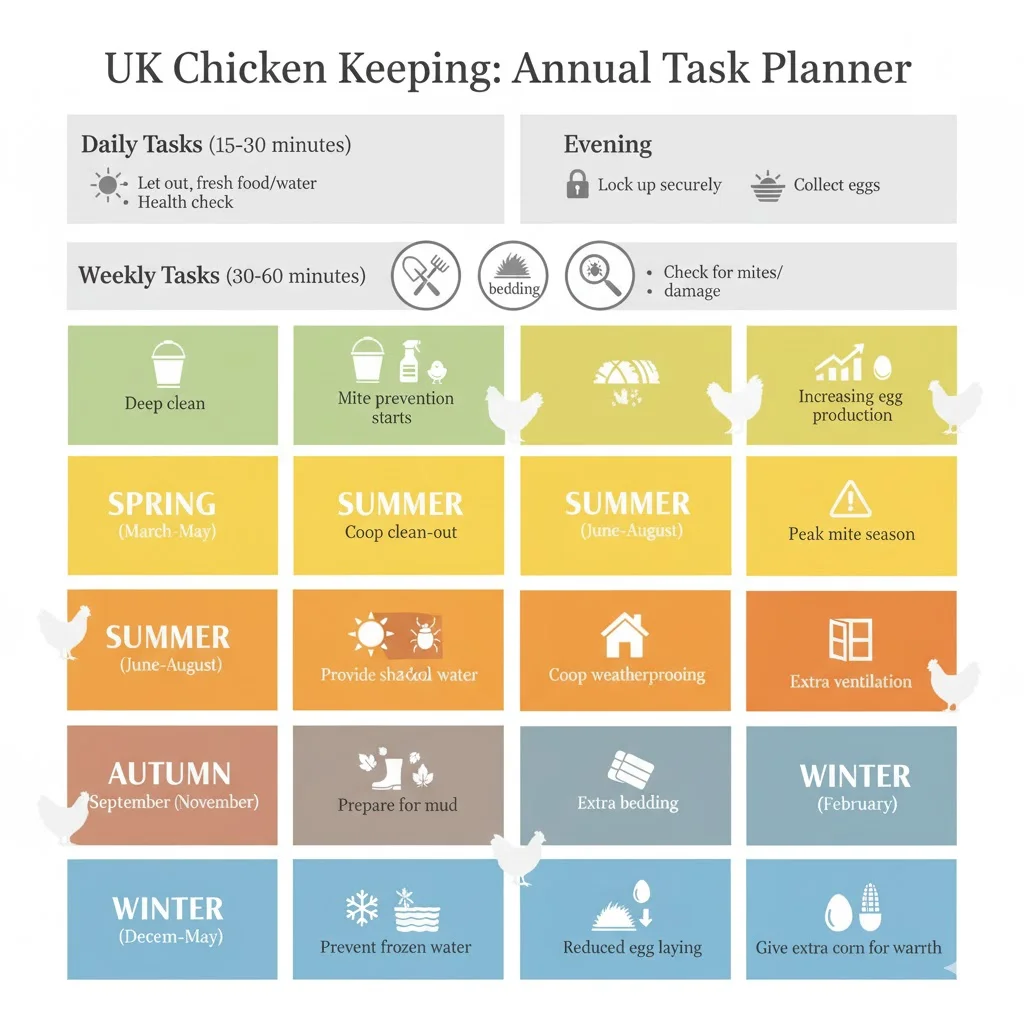
No, but they do require daily commitment. You can’t just go away for a weekend without a plan.
- Daily (15-30 mins): Let them out, give fresh food and water, check they are all healthy, collect eggs, and lock them up securely at dusk. This last step is vital to protect them from foxes.
- Weekly (30-60 mins): A full coop clean-out (poo picking, fresh bedding).
- Seasonal Tasks:
- Spring: A “deep clean” of the coop after winter. The perfect time to check for red mites as the weather warms up.
- Summer: Ensure they have plenty of shade and fresh, cool water. Risk of heatstroke is high. This is also peak red mite season.
- Autumn: Prepare for mud! Put down woodchips in the run. If it gets really bad, we have solutions for muddy runs in wet weather.
- Winter: Stop their water from freezing (a £10 heated water base is a lifsave). Give a little extra corn in the afternoon for warmth.
Will I Get Rats If I Keep Chickens?
Chickens themselves don’t attract rats, but their feed does. This is a very common problem, but it’s 100% preventable.
- Store Feed Securely: Keep all feed in a metal bin with a secure lid. Rats will chew through plastic bags and boxes overnight.
- Clean Up Spills: Tidy up any spilled feed at the end of the day.
- Use a Treadle Feeder: As mentioned earlier, this is the number one solution. It only opens when a chicken stands on it.
- Remove Feeder at Night: If you have a simple feeder, take it inside at night when you lock the hens up.
For a more in-depth look, read our detailed guide to keeping rats away.
How Much Space Do Chickens Need in the UK?
More space is always better. Overcrowding leads to stress, feather pecking, bullying, and disease.
- Inside Coop: A minimum of 2-4 square feet per bird.
- Outside Run: A minimum of 8-10 square feet per bird.
These figures are minimums. Our detailed space requirements guide explains why more space is always better for a happy flock.
If you can let them free-range in your garden (under supervision), they will be even happier. These are good minimums, but the official UK welfare codes recommend giving them as much space as possible to allow for natural behaviours like foraging and dust bathing.
Answering these common worries helps you plan, but what about the costs nobody tells you about? I call these the “surprise” expenses.
Hidden Costs to Consider
These are the costs that surprised me and many other chicken keepers.
Predator Protection Upgrades
A fox will find your chickens. Your £150 budget coop might not be strong enough. Investing in one of the fox-proof coop options for UK keepers from the start can save you this extra cost and a lot of heartaches.
- A fox can tear through cheap chicken wire; you need welded mesh.
- They can also dig, so you should lay a “skirt” of mesh on the ground around the coop, pegged down.
- I spent an extra £30 on stronger locks and extra bolts for my first coop.
Predator Losses (The Heartbreak Cost)
This is related to the point above, but it’s a different kind of cost. No matter how careful you are, a fox can sometimes find a way in. Losing a hen is genuinely heartbreaking, but there’s a financial cost too. You’ll have to pay for a replacement bird (£16 – £35) and will lose out on the eggs from that hen.
Emergency Vet Visits
Most vets are not poultry vets. You must find a local “exotic” or poultry vet before you get your birds. A simple consultation can be £50 – £90 before any treatment. I had one hen with an egg-laying issue (egg-bound), and the vet visit was £90. You should have a £100-£200 “emergency fund” just in case. It’s also helpful knowing when to seek veterinary care versus when you can treat at home.
Unexpected Biosecurity During Outbreaks
When there’s a major Avian Flu (Bird Flu) outbreak, DEFRA will declare a “housing order.” This is a legal requirement to keep your birds indoors and fully covered to stop them mixing with wild birds. This can mean you suddenly need to buy:
- Tarpaulin: To cover the top of your run (£20 – £40).
- Extra Bedding: Because they’ll be in their run 24/7, it will get muddier and messier, fast.
- Boredom Busters: Things like corn, perches, and pecking toys to stop them from getting stressed and pecking each other (£10 – £20).
Coop Repairs and Upgrades
This was my big one. My £200 coop needed a new roof felt (£25) and a new lock (£10) within 6 months. That’s the real hidden cost of buying cheap.
Temporary Housing
This is one I learned the hard way. If you need to do a major coop repair (like replacing a whole panel) or a deep-clean for red mites (which can take a full day), where do the chickens go? I had to buy a large pop-up pet crate (£25) to keep them in safely while I worked.
Holiday Chicken-Sitters
You can’t leave your chickens for a weekend. The daily lock-up is essential. You’ll need a kind neighbour or a “chicken-sitter.” A professional sitter can cost £10-£15 a day.
Replacement Birds
This is a sadder one. A hen’s prime laying years are 1-3. After that, production drops. You’ll need to decide if you’ll keep them as pets (and pay for their feed for 5+ more years) or get new, younger birds.
It sounds like a lot, but don’t be put off! There are plenty of smart ways to keep these costs right down from the very beginning.
Money-Saving Tips for UK Chicken Keepers
You can definitely do this on a tighter budget.
Go DIY on the Coop
If you’re handy, you can build a secure coop for a fraction of the cost. A popular option is building from reclaimed pallets (often free), costing you less than £50 for screws, hinges, and roofing felt.
Buy Second-Hand (With a Warning)
Look on Facebook Marketplace or Gumtree for coops and runs. You can get a £500 setup for £150. BUT you MUST disinfect it thoroughly with a poultry-safe product (like Virkon S) to kill any red mites or diseases left by the last flock.
Rescue Hens
Adopt from a charity like the British Hen Welfare Trust (BHWT). For a £2.50-£5 donation per hen, you’re getting a hen that is still laying and giving it a wonderful retirement.
The ‘Deep Litter Method’
This is a great tip. Instead of a full clean-out every week, you use the “deep litter method.” You start with a deep (4-6 inch) layer of bedding (hemp or wood chips are best) and just “turn” it with a fork every few days, adding a fresh thin layer on top. Twice a year, you do a full clean-out. This builds up a “compost” layer that generates its own warmth in winter and saves a fortune on bedding.
Bulk Buy (Smartly)
Buy feed and bedding in larger quantities. But only buy what you can use in 3-4 months, as the vitamins in feed degrade over time. And make sure it’s stored in that metal-lidded bin!
Saving money is great, but the real reward is a happy, healthy flock. Let’s pull everything together.
Frequently Asked Questions (FAQ) on How much does it cost to keep chickens in the UK?
How much does it cost to keep chickens in the UK for the first year?
For a small flock of 4 hens, you should budget between £1,000 and £1,500 for the first year. This includes one-off setup costs (coop, fencing, hens) and ongoing running costs (feed, bedding).
How much does it cost per month to keep chickens?
After the first-year setup costs, the ongoing running cost for 4 chickens is very manageable, at around £20 to £30 per month. This mainly covers feed and bedding.
Do I need to register my chickens in the UK?
Yes. As of October 1, 2024, all chicken keepers in England and Wales must register their birds, even if you only have one. Registration is free via the GOV.UK website for the Great Britain Poultry Register (GBPR).
Is it illegal to feed chickens kitchen scraps in the UK?
Yes, it is illegal to feed your chickens any kitchen waste, even from a vegan household. This is a critical biosecurity law to prevent the spread of disease. You can, however, feed them fresh greens from your garden that have not entered your kitchen.
How many chickens should a beginner start with?
A beginner should start with 3 or 4 hens. Chickens are social birds and must not be kept alone, so 3-4 is a perfect number to manage and get a good supply of eggs.
Will I get rats if I keep chickens?
Chickens don’t attract rats, but their feed does. You can easily prevent rats by storing all feed in a metal bin with a secure lid and cleaning up any spills daily. Using a treadle feeder is also a highly effective solution.
Conclusion: So, What’s the Real Total?
So, there you have it. Keeping chickens isn’t a cheap hobby to start. You are looking at a first-year investment of £600 on the very low end and more realistically £1,000 – £1,500 for a quality, lasting setup for 4 hens.
After that, the running costs are very manageable, at around £20-£30 per month.
You won’t get rich selling eggs, and you won’t save a fortune on your grocery bill, at least not for the first couple of years. But what you will get is the joy of collecting your own fresh eggs, the peace of mind knowing your animals are well-cared for, and hours of entertainment from some of the funniest, most rewarding pets you’ll ever own.
And for me, that’s worth every penny.

Oladepo Babatunde is the founder of ChickenStarter.com. He is a backyard chicken keeper and educator who specializes in helping beginners raise healthy flocks, particularly in warm climates. His expertise comes from years of hands-on experience building coops, treating common chicken ailments, and solving flock management issues. His own happy hens are a testament to his methods, laying 25-30 eggs weekly.
